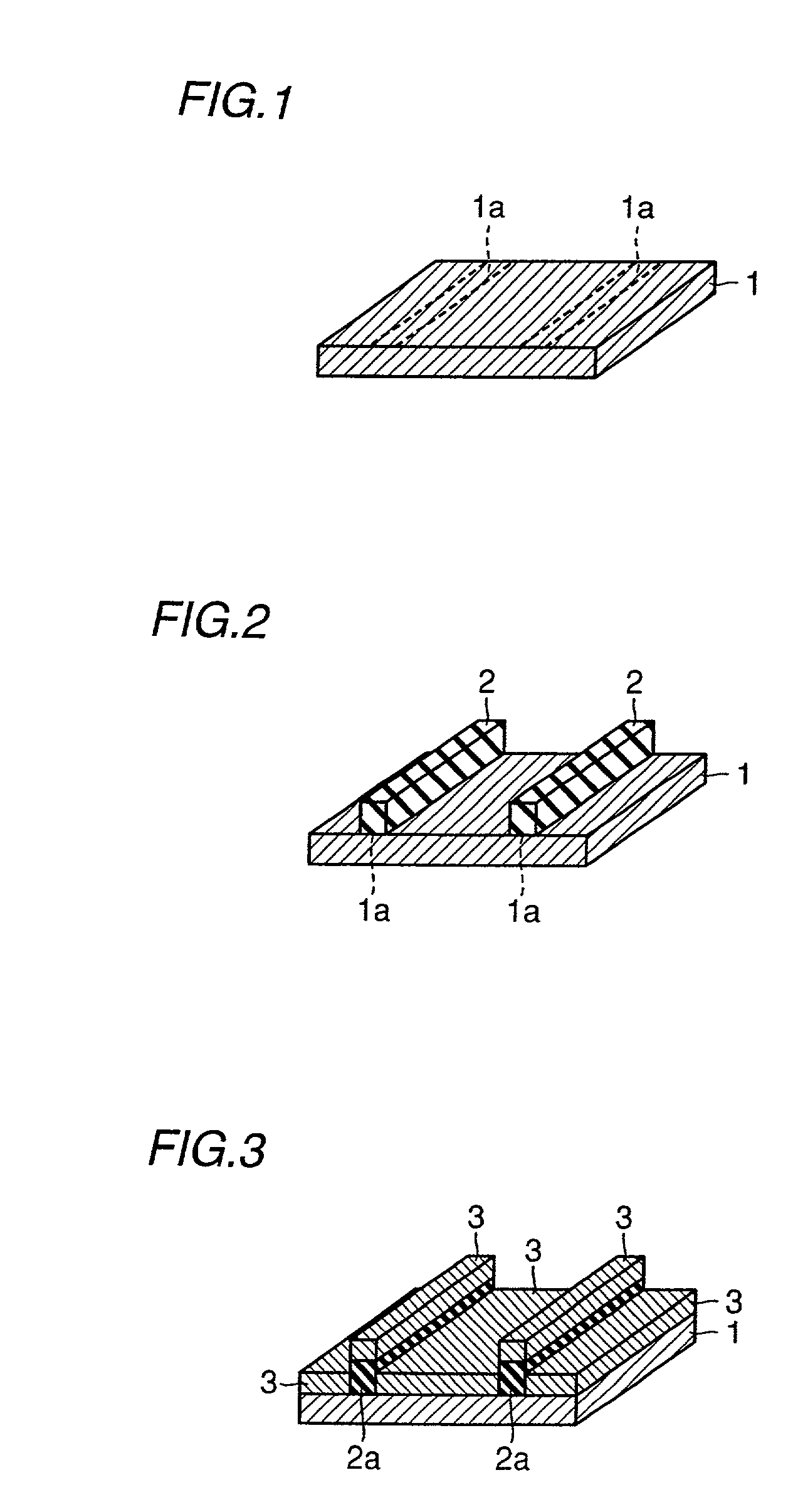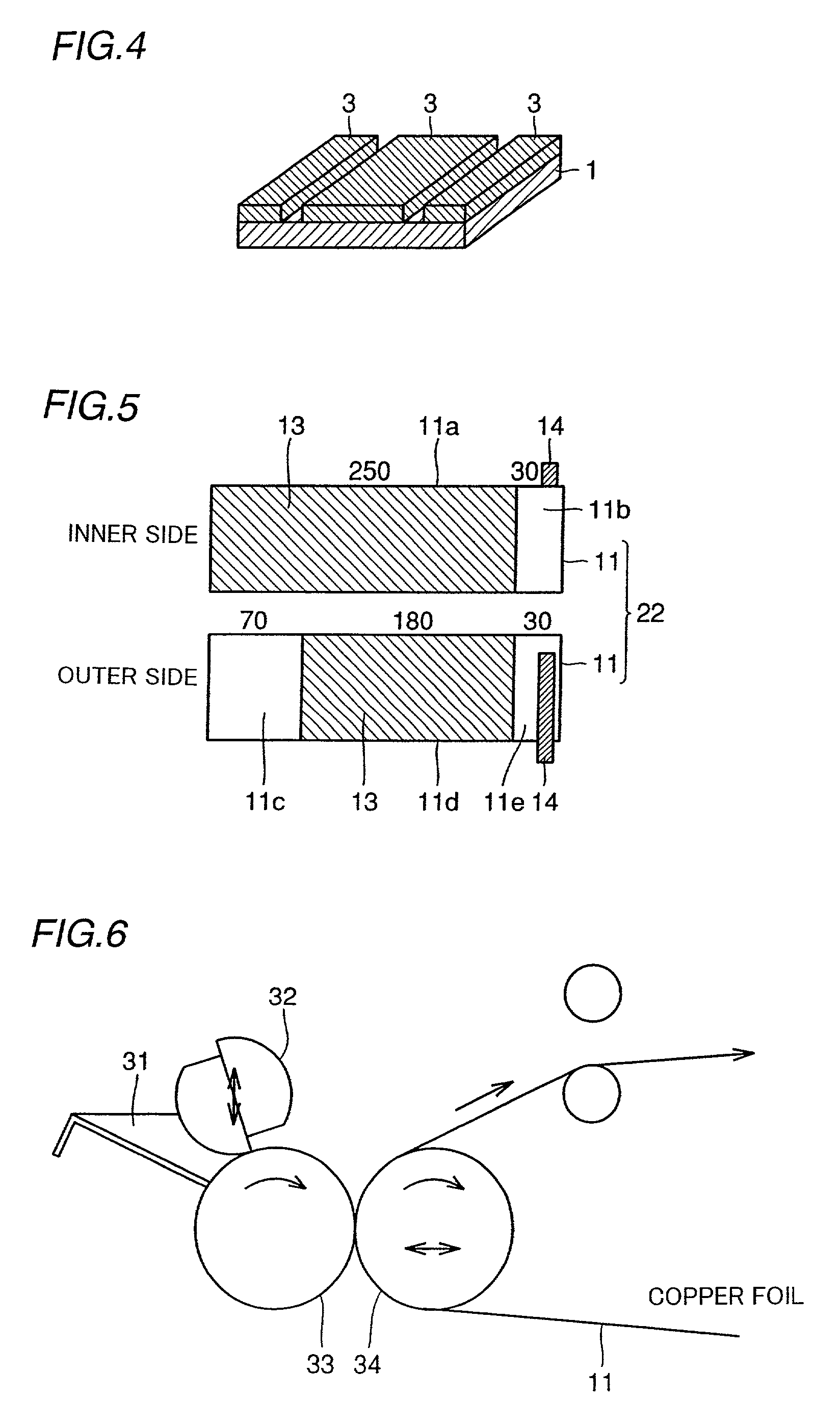Method of manufacturing electrode for secondary cell
- Summary
- Abstract
- Description
- Claims
- Application Information
AI Technical Summary
Benefits of technology
Problems solved by technology
Method used
Image
Examples
example 1
[0041]Example 1 of the present invention is described with reference to mask layers consisting of styrene-butadiene rubber (SBR) reduced in adhesion to a collector due to a high temperature for forming active material layers when forming a negative electrode of a lithium secondary cell.
[0042][Preparation of Negative Electrode]
[0043]Before describing actual conditions for preparing a negative electrode according to Example 1, the process of preparing the negative electrode is conceptually described with reference to FIGS. 1 to 4. According to Example 1, a collector 1 is first prepared as shown in FIG. 1. Then, regions 1a requiring formation of no active material layers such as tab portions etc. are specified on the surface of the collector 1. As shown in FIG. 2, mask layers 2 consisting of a material reduced in adhesion to the collector 1 due to a high temperature for forming active material layers 3 (see FIG. 3) described later are formed on the regions 1a of the collector 1 requiri...
example 2
[0057]Example 2 of the present invention is described with reference to resist layers employed as mask layers formed on a collector in preparation of a negative electrode. More specifically, the overall surface of a previously electrolyzed electrolytic copper foil member having a thickness of 20 μm forming a collector was electrodeposition-coated with a liquid emulsion mainly composed of a copolymer of methyl methacrylate, n-butyl acrylate and methacrylic acid, thereby forming resist layers (PHOTO-ED P5000 by Nippon Paint Co., Ltd.) in a thickness of 20 μm. Thereafter exposure and development were performed for forming mask layers consisting of the resist layers having patterns similar to those in Example 1. Active material layers consisting of amorphous silicon layer having a thickness of about 6 μm were formed on the collector consisting of the electrolytic copper foil member and on the mask layers by sputtering. The amorphous silicon layers were formed under conditions of power (...
example 3
[0061]Example 3 of the present invention is described with reference to heat-resistant tapes consisting of polyimide resin employed as mask layers for preparing a negative electrode. According to Example 3, heat-resistant tapes of polyimide resin having a thickness of about 60 μm were applied onto a collector consisting of a previously electrolyzed electrolytic copper foil member having a thickness of 20 μm in the same patterns as those shown in Example 1. An active material layer consisting of amorphous silicon was formed on the overall surface of the electrolytic copper foil member (collector) having the heat-resistant tapes of polyimide resin applied thereto in a thickness of 6 μm by sputtering under the same conditions as those in Example 1. When the heat-resistant tapes of polyimide resin were thereafter separated, the surface of the electrolytic copper foil member requiring formation of no active material layers could be exposed. The remaining parts of the amorphous silicon la...
PUM
 Login to View More
Login to View More Abstract
Description
Claims
Application Information
 Login to View More
Login to View More - R&D
- Intellectual Property
- Life Sciences
- Materials
- Tech Scout
- Unparalleled Data Quality
- Higher Quality Content
- 60% Fewer Hallucinations
Browse by: Latest US Patents, China's latest patents, Technical Efficacy Thesaurus, Application Domain, Technology Topic, Popular Technical Reports.
© 2025 PatSnap. All rights reserved.Legal|Privacy policy|Modern Slavery Act Transparency Statement|Sitemap|About US| Contact US: help@patsnap.com



